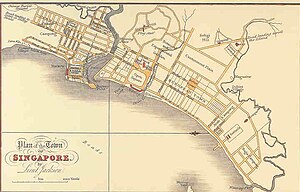
Urban planning in Singapore is the direction of infrastructure development in Singapore. It is done through a three-tiered planning framework, consisting of a long-term plan to plot out Singapore's development over at least 50 years, a Master Plan for the medium term, and short-term plans, the first two of which are prepared by the Urban Redevelopment Authority (URA) and the last by multiple agencies.
Planning in Singapore first began with the Jackson Plan in 1822, which divided Singapore town into multiple ethnic areas and established Singapore as a commercial and administrative centre. For a century, the colonial authorities in Singapore were not very involved in its development until they began engaging in urban regulation in the 1890s, in response to congestion and squatter settlements. When this proved inadequate, the British established the Singapore Improvement Trust (SIT) in 1927, which had limited powers and hence limited initial impact. Detailed urban planning for Singapore eventually started in the 1950s, with the goal to give Singapore a wider economic role in the Federation of Malaya. The 1958 plan was produced as a result, heavily influenced by British planning practices and assumptions.
After Singapore's independence in 1965, planning policies were revised, and the State and City Planning Project was initiated to produce a new plan for Singapore, which became the 1971 Concept Plan. This plan laid out the basic infrastructure for Singapore's development and brought about the integrated planning process used ever since. Planning in Singapore began to incorporate additional priorities from the 1980s, such as quality of life and conservation, while the 1991 revision of the Concept Plan introduced the concept of regional centres to promote decentralisation. To improve the implementation of the Concept Plan's strategies, Singapore was divided into multiple planning areas in the 1990s, and comprehensive plans for each area's development were produced and compiled into a new plan. In the 2001 and 2011 concept plan, Singapore's urban planners began to incorporate public feedback and opinions into the planning process, shifting towards liveability and sustainability, while prioritising economic development as the powerhouse of each plan's success. The 2011 Concept Plan also featured a distinct focus on sustainability and conservation. The most recent plan is the 2019 masterplan, which details Singapore's increasing consideration towards sustainability, cultural preservation, building communities and closing resource loops.